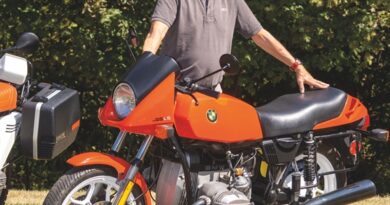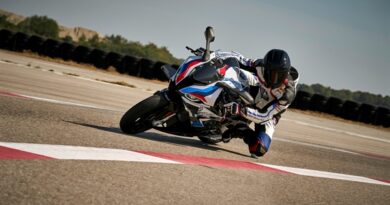F 850 GS: Late, but worth the wait!
Photos by Kevin Wing
Over the years, I’ve spent more time on an F 800 GS than any other motorcycle. While it has a special place in my heart, there were always a few things I wished were different. In my mind, the 800’s biggest shortcomings were its lack of power, soft suspension and the stiff clutch pull. A couple other minor complaints included the need to repeatedly turn off the ABS when riding off road, and the bike’s traction control introduced in 2013 was useless on dirt.
 After a 10-year run, the team at BMW Motorrad is finally giving us the long-awaited replacement to this middle-weight adventure bike. While the F 850 GS is similar in name to its predecessor, it’s got an entirely different personality. Let me put it another way. If the F 800 GS was a choir boy, the F 850 GS is more of a Beastie Boy. This new GS has got a wild side.
After a 10-year run, the team at BMW Motorrad is finally giving us the long-awaited replacement to this middle-weight adventure bike. While the F 850 GS is similar in name to its predecessor, it’s got an entirely different personality. Let me put it another way. If the F 800 GS was a choir boy, the F 850 GS is more of a Beastie Boy. This new GS has got a wild side.
At an MOA rally several years ago, I recall an MOA member approaching Pieter DeWall, the former Motorrad boss for North America, and asking, “Why don’t you make your bikes sound exciting? I love my GS, but it sounds like a sewing machine.”
 He may not have been the only one feeling that way, because BMW has responded in a big way. The new F 850 GS power plant features a 270-degree firing order that produces an angrier sounding growl than the F 800 GS could have ever dreamed of. The newest GS not only sounds exciting, it backs its snarl up with seriously snappy power delivery. The bike pulls hard on pavement and offers a spirited ride through the twisties. On the dirt, it claws its way through mountains and rough terrain while painting a permanent grin on your face.
He may not have been the only one feeling that way, because BMW has responded in a big way. The new F 850 GS power plant features a 270-degree firing order that produces an angrier sounding growl than the F 800 GS could have ever dreamed of. The newest GS not only sounds exciting, it backs its snarl up with seriously snappy power delivery. The bike pulls hard on pavement and offers a spirited ride through the twisties. On the dirt, it claws its way through mountains and rough terrain while painting a permanent grin on your face.
Ride Modes
The available ride modes of the F 850 GS customize the way the throttle response, traction control, anti-lock brakes, and dynamic suspension damping come together to optimize the way the bike behaves to match the riding situation. Available modes include Road, Rain, Dynamic, Enduro, and Enduro Pro and I like to think of them as computerized intervention helping a rider stay out of trouble.
 While Road and Dynamic modes work to make the bike more exciting to ride with a strong power delivery, Rain mode dramatically limits wheel spin on the throttle and provides generous amounts of ABS to keep you from locking up the wheels while braking. I was glad I had the Rain mode when coming down from a high mountain pass in snow showers with 32 degrees indicated on the dash.
While Road and Dynamic modes work to make the bike more exciting to ride with a strong power delivery, Rain mode dramatically limits wheel spin on the throttle and provides generous amounts of ABS to keep you from locking up the wheels while braking. I was glad I had the Rain mode when coming down from a high mountain pass in snow showers with 32 degrees indicated on the dash.
My favorite mode is Enduro Pro which provides the perfect traction control for riding dirt. It allows you to drift the back end while under throttle but keeps you from going too far. Still fun, but with a feeling of safety. In Enduro Pro mode a rider maintains full control of the rear brake while allowing you to skid the rear tire to initiate turns and have fun. Enduro Pro still provides off-road ABS on the front end to keep the front wheel from locking up. The bike really stops well with the front brake in this mode. What’s really nice with the F 850 GS when compared with its predecessor is that these settings are retained when turning the bike off. Thank goodness!
 Gear Shift Assist Pro
Gear Shift Assist Pro
This is something I never would have asked for, but found pretty nice once I got used to it. This technology allows you to shift up or down without using the clutch or backing off on the throttle. I found I could rev it up close to red line and with the throttle fully twisted open, kick-it up a gear without touching the clutch. It’s like magic! In practical use, when you come out of a corner in too high of a gear, you simply kick it down without backing out of the throttle and bam, you are in the right gear without missing a beat.
Suspension
I found the suspension on the original F 800 GS to be too soft when pushing the bike off road. It regularly bottomed out, making aftermarket suspension installation necessary to improve the handling. The F 850 GS is much better in all terrain and situations. To adjust the suspension, riders chose between the Standard, Luggage or Two-rider settings to electronically increase the preload and change damping characteristics of the rear shock. For aggressive off-road riding, I put the bike in Two-rider mode and loved the way it performed. I pushed the bike hard on challenging terrain and only bottomed it out a few times. On the street, the bike had a nice planted feeling and was comfortable to ride in the standard “single rider with no luggage” setting.
 Cross spoke wheels and tubeless tires
Cross spoke wheels and tubeless tires
In many ways this F 850 GS is the recipient of many great attributes of its bigger sibling, the R 1200 GS, and cross-spoke wheels and tubeless tires are a great example. Fixing a flat without removing a wheel is always a benefit in my book.
TFT Display
I’m a little bit “grumpy old man” about all the high-tech stuff on an adventure motorcycle, but the TFT has grown on me. It’s crystal clear and easy to read, even in full sunlight, and easy to navigate through the available settings. The start-up sequence alone is pretty cool. Using the BMW Motorrad Connected app, a smart phone can be connected via Bluetooth to allow navigation information to appear on the display. Add a communication system and you can answer calls or listen to music. Navigating the display menus and settings is convenient with the handlebar-mounted multi controller.
 Useable Power
Useable Power
The bike feels like it has more power than the stated 90 hp, and I would have guessed a higher number after riding the bike. I found the bike downright exciting to ride and a big improvement over its predecessor. Gone is the need to downshift and ring out the motor when passing cars as was necessary on the F 800 GS; the F 850 GS simply moves. Off-road, the bike has plenty of power and in Enduro Pro, it provides great traction and pulls up mountains and through varied terrain.
Ergonomics
The buttery smooth clutch pull made me very happy. I remember a long, technical ride at the 2014 ADV Rally – Sierra Edition on my F 800 GS where my clutch hand gave out from having to feather the stiff clutch so much. That won’t be an issue with the F 850 GS. I found that the front brake also has great modulation and can be operated all day long with just one finger.
 I do have few gripes about this bike, and one is that I found the rear brake pedal to be too low to operate when standing; I wish it had more adjustment range to position it higher. I recently put Touratech lowering foot pegs on my bike, and this greatly helped my ability to operate the rear brake. My left foot also had a complaint. The shift lever was too short to get my size 11.5 Motocross boots under it, and an adjustable shift lever will soon be installed.
I do have few gripes about this bike, and one is that I found the rear brake pedal to be too low to operate when standing; I wish it had more adjustment range to position it higher. I recently put Touratech lowering foot pegs on my bike, and this greatly helped my ability to operate the rear brake. My left foot also had a complaint. The shift lever was too short to get my size 11.5 Motocross boots under it, and an adjustable shift lever will soon be installed.
The F 850 GS will be available in four seat configurations, which will provide a range of seat heights from 35 inches down to 32.9 inches and with the factory lowered suspension, a 32.1-inch seat height can be achieved.
 Why the Wait?
Why the Wait?
The launch of the F 850 GS was delayed by BMW and the rumor mill was churning full steam about problems with the motor from the new Chinese supplier. The explanation offered by Mike Peyton, Vice President of Motorrad America, was that because of BMW’s high quality standards, the company took the time required to bring this new supplier up to the BMW quality. This isn’t the first time BMW has delayed a new model, and it probably won’t be the last. The good news is they take the time and usually get it right.
 BMW F 750 GS
BMW F 750 GS
While we didn’t spend as much time with the F 750 GS, there is a lot to like about the F 850’s little brother. I think it’ll be a good fit for a lot of riders.
If you are short on inseam or budget, this bike is made for you. It’s got many of the attributes of the F 850 GS, but with a stronger street personality with its 19 inch front wheel and a suspension more suited for street than demanding off-road.
 Most of the good characteristics in the F 850 GS are present in the F 750 GS in terms of electronics package, styling, and motor, albeit with 77 hp instead of the full 90 hp. The biggest difference between the two models is the F 750 GS’s lower seat height at 32.1 inches which drops to 30.3 inches with a lowered suspension model.
Most of the good characteristics in the F 850 GS are present in the F 750 GS in terms of electronics package, styling, and motor, albeit with 77 hp instead of the full 90 hp. The biggest difference between the two models is the F 750 GS’s lower seat height at 32.1 inches which drops to 30.3 inches with a lowered suspension model.
A constant complaint I hear about adventure bikes is that they are too tall. BMW has solved that problem with the F 750 GS while offering a good option for those who want to touch the ground but still live for their two-wheel adventures.
With a base price $2,800 less than the F 850 GS, the F 750 GS is a lot of motorcycle for the money. For the average rider, this bike will do everything you need off-road while exceeding expectations on the street. The F 750 GS impressed all of us at the press launch, and apparently, there was some spirited riding happening on this bike. I overheard other journalists at the cocktail party talking about hitting triple digit speeds in 5th gear. Even with street tires, I was still impressed with how well it did in the dirt. That being said, if you want Enduro Pro mode, you’ll have to opt for the F 850 GS as the F 750 GS only offers Enduro mode for dirt riding.
Conclusions
Overall, I was very pleased with BMW’s new F 850 GS and believe it’s a strong contender in the 21 inch front wheel class of middle-weight adventure motorcycles. BMW performed a miracle when they increased ground clearance by 1.3 inches while at the same time, lowered the seat height by 0.7 inches. They also moved the fuel tank to the front which allows the bike to be skinnier in the middle for improved ergonomics when standing. I felt much more comfortable standing on this bike than I did with its predecessor. The balance and handling are really good on the 850 GS, and the rich exhaust note sounds downright rowdy for a BMW.
The wait is over and the new F 850 GS and F 750 GS are finally here.



